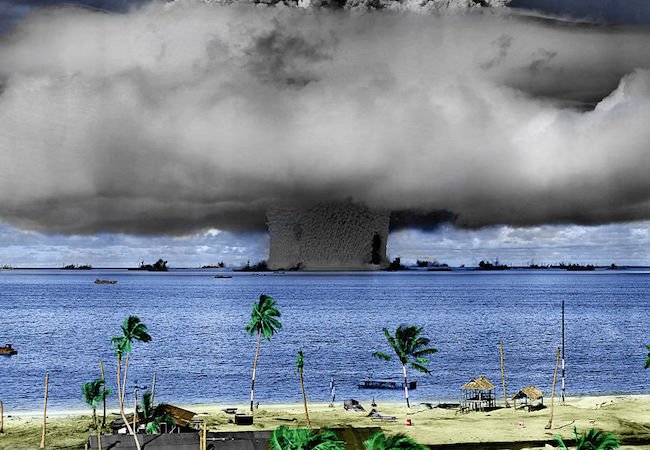
By Beenish Altaf
For the 2020 NPT Review Conference, the Preparatory Committee is scheduled to hold its second session from 23 April to 4 May 2018 at the United Nations Office in Geneva. The prospects for the next review conference do not look particularly bright owing to the fact that Non-Proliferation Treaty (NPT) member states’ fail to reach to a consensus point on how to progress on non-proliferation and disarmament measures individually or institutionally. Similarly the fear about the future of the regime is a continual dilemma globally. Even though, the indefinite extension of the NPT in 1995 apparently represents the strong will of the majority of signatory states to work on creating a non-proliferation regime that makes the cost of non-compliance high enough to deter potential violators. In the last Review Conference of 2015, the Signatories met to strengthen the non-proliferation regime, but could not come to an agreement. The question of why the 2015 RevCon could not produce a workable concrete document for the adherence to nuclear non-proliferation regime should be taken into account critically.
Andrey Baklitsky narrates the reasons for the NPT Rev Con’s failure to produce any final document in his article titled “The 2015 NPT Review Conference and the Future of the Nonproliferation Regime.” First, concluding the NPT RevCon without an agreement is nothing unusual. Since 1970, when the treaty entered into force, the parties could not reach a multilateral consensus at four of the last nine RevCons: 1980, 1990, 2005, and 2015. Indeed, this is a poor record for a treaty that is considered to be a universal treaty. The conclusion of 2015 NPT RevCon is assessed to be disappointing because it could not wrap-up into a final document especially in the field of non-proliferation. On the other hand, even though the implementation is still debatable, the 2000 and 2010 review conferences are considered to be successful as they agreed on two concrete documents: 13 “practical steps” and the 64-point action plan RevCon in 2000 and 2010 NPT respectively. Secondly, since 1985, the outcome of NPT review conferences has not been changed much. The world order changed from the bipolar world and also a few countries got nuclearized by conducting their nuclear weapon tests, i.e. Pakistan, India and North Korea, but the focus of attention of the NPT RevCon remained on the Article VI of the treaty related to disarmament. On the other hand the blazing issue of the creation of a Nuclear Weapons Free Zone free (NWFZ) in the Middle East that was debated a lot in the 2015 NPT review Conference remained a subject of concern since 1974. Third, it is evaluated in the NPT RevCon that both countries, Russia and the US still criticize each other over the suspected disobedience of the international agreements despite implementing few arms control agreements, e.g., the New Strategic Arms Reduction Treaty and the Intermediate-Range Nuclear Forces Treaty. There is another positive sign that Moscow and Washington also continue to work together in the P5 process.
Talking about the disarmament initiative, the contemporary situation of Russia and the US initiatives is assessed as follows. The point of concern is Russia’s apprehensions on the reduction of nuclear warheads from their countries (the US and Russia) to 1000 warheads (as announced in international reports) apiece. Since with regards to strategic stability between both countries, a precondition to reduce or cut down the number of nuclear warheads, Russia apprehends that the US is violating or undermining it’s commitment of reducing nukes by developing prompt global-strike systems, expanding its ballistic missile defense and opposing the draft treaty banning weapons in outer space. So, for initiating the disarmament talks again whether bilateral or multilateral, one needs to employ new inter-governmental dynamics or make use of creative diplomacy; this would positively be an add on from the non-proliferation perspective too.
The international non-proliferation regime has not only been inadequate in dealing with instances of proliferation, but also undermined the objectives of the Article IV of the NPT on transfer of nuclear technology for exclusively peaceful purposes. Lack of consensus at the NPT review conference is hardly new, but the willingness to cooperate or reconcile differences and find consensus is fading. As a result, states that cannot find satisfaction from this forum are beginning to look towards other alternatives to fulfill their disarmament and non-proliferation demands. There have been suggestions to shift non-proliferation discussions that make decisions by majority instead of consensus reached by the United Nation General Assembly or other ad hoc body. Leaving the outcome aside whether such a move would result in the desired change or not, it would definitely weaken the NPT review process and consequently the nonproliferation regime itself. Despite any short-comings of the 2015 review conference, no other nuclear disarmament arrangement has made substantial progress in restraining the proliferation of nuclear weapons. The Treaty on Prohibition of Nuclear Weapons was drafted in 2017 but unfortunately it too could not gain much momentum in this regard. It too is in the need of recognition by all the nuclear weapons states but the chances of that are quite bleak for at least in the near future. However, progress over the next NPT RevCon will be crucial for the permanence of this treaty.




